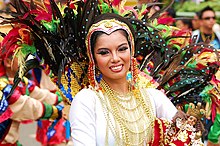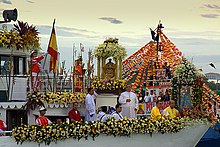
The Sinulog-Santo Niño Festival is an annual cultural and religious festival held on the third Sunday of January in Cebu City, and is the center of the Santo Niño Catholic celebrations in the Philippines. Other places like Maasin City, Balingasag, Misamis Oriental and Southern Leyte also have their own version of the festival in honour of the Santo Niño.
One of the main highlights of the festival is the grand street parade which lasts for 9 to 12 hours (practically the entire day) with participants coming from the different towns and cities of Cebu and from Luzon, Visayas and Mindanao across the Philippines. The Sinulog dance contingents are dressed in bright coloured costumes dancing gracefully to the rhythm of drums, trumpets and native gongs. Smaller versions of the festival are held in various parts of the province, also to celebrate and honor the Santo Niño. There is also a "Sinulog sa Kabataan" performed by the youths of Cebu a week before the parade. Recently, the festival has been promoted as a tourist attraction, with a contest featuring contingents from various parts of the country. The Sinulog Contest is usually held in the Cebu City Sports Complex.
The Sinulog Festival competition is divided into three (3) categories namely the Street Dancing Category, Free Interpretation and Sinulog base categories. The free interpretation category has the most number of participating contingents coming from outside Cebu. The dance steps are fast and the storyline and theme varies from folkloric, mythical and historical lines. The Sinulog-based category centers more on the Sinulog ritual dance worship and the choreography is more "formal" the dance steps depicts the prayer dance which is the true identity of the Sinulog ritual dance. The Sinulog-based participants wear Filipiniana and Hispanic inspired costumes. The Grand Champion of the Free Interpretation, Street Dancing, and Sinulog base categories wins one million pesos (P1,000,000.00) respectively. The Sinanduloy Dance Troupe of Tangub City, Misamis Occidental is a consistent winner in the Sinulog-based category. Carcar City of Cebu also proved their mastery of the Sinulog dance and they always end within the top 5 places in the Sinulog Competition. The famous Lumad Basakanon dance contingent of Basak San Nicolas, Cebu City has won several Free Interpretation titles in Sinulog and made history when they were elevated to the Aliwan Fiesta Hall of Fame for winning the national streetdancing champioship during Aliwan Fiesta 2006, 2007, 2008 and 2014. Sinulog Festival showcases the most number of participants and the best choreographic exhibition of any festival in the Philippines.

The Sinulog celebration lasts for nine days, culminating on the final day with the Sinulog Grand Parade. The day before the parade, the religious Fluvial Procession sponsored by the Archdiocese of Cebu is held at dawn with a statue of the Santo Niño carried on a beautifully decorated boat which sails from Mandaue City to Cebu City, decked with hundreds of flowers and candles. The procession ends at the Basilica Minore del Santo Nino de Cebu where a re-enactment of the baptism to the Christian faith (that is, the acceptance of Roman Catholicism) of Cebu is performed. In the afternoon, a more solemn procession takes place along with the major streets of Cebu City, which last for hours due to large crowd participation in the event.

The word Sinulog comes from the Cebuano adverb sulog which roughly means "like water current movement;" it describes the forward-backward movement of the Sinulog dance. The dance consists of two steps forward and one step backward, done to the sound of drums. The dance is categorized into Sinulog-base, Free-Interpretation, and street dancing. Candle vendors at the Basilica continue to perform the traditional version of the dance when lighting a candle for the customer, usually accompanied by songs in the native language.
Sinulog is the ritual prayer-dance honoring Señor Santo Niño or the Child Jesus. An image of the Child Jesus is said to be the baptismal gift the Portuguese conquistador Ferdinand Magellan gave Hara Amihan (Humanay) of Zebu (now Cebu) in April 1521. The image, believed to be miraculous, is housed at the Basilica Minore del Santo Niño in downtown Cebu City.
The Sinulog dance moves are basically two steps forward and one step backward as the dancer sways to a distinct rhythm of drums. This movement resembles the current (Sulog) of what was known as Cebu’s Pahina River.
According to historical accounts, the Zebu natives already danced the Sinulog in honor of their animist idols long before the arrival of Magellan who led a Spanish expedition on April 7, 1521. Magellan did not live long after he introduced Christianity. He died in a failed assault on nearby Mactan island at the hands of a local chieftain named Lapu-Lapu.
Survivors of Magellan's expedition left behind the image to be discovered 44 years later.
The expedition led by Miguel Lopez de Legaspi bombarded the native settlement when they arrived on April 28, 1565. In one of the burning huts, one of Legaspi's men, Juan Camus, discovered the image of the Santo Niño inside a wooden box beside other idols. This time however, Legaspi discovered that the natives already dance the Sinulog honoring the Santo Niño.
Today, the Sinulog commemorates the Filipino people's acceptance of Christianity (specifically, Roman Catholicism), and their rejection of their former animist beliefs. The first of these conversions happened in 1521 on the island of Cebu, when Rajah Humabon and his queen Amihan (Humamay) were baptized along with their subjects, becoming Carlos and Juana of Cebu.
On April 15, 1521, the Portuguese explorer Ferdinand Magellan arrived and planted the cross on the shores of Cebu, claiming the territory for Spain. He presented the image of the child Jesus, the Rajah Humabon. Hara Humamay (or Amihan in some versions) was later named, Queen Juana in honor of Juana, mother of Carlos I. Along with the rulers of the island, some 800 natives were also baptized to the Roman Catholic Church. At the moment of receiving the holy image, it was said that Queen Juana danced with joy bearing this image of the child Jesus. With the other natives following her example, this moment was regarded as the first Sinulog.
This event is frequently used as basis for most Sinulog dances, which dramatize the coming of the Spaniards and the presentation of the Santo Niño to the Queen. A popular theme among Sinulog dances is Queen Juana holding the Santo Niño in her arms and using it to bless her people who are often afflicted by sickness caused by demons and other evil spirits.
The Sinulog dance steps are believed to originate from Rajah Humabon's adviser, Baladhay. It was during Humabon's grief when Baladhay fell sick. Humabon ordered his native tribe to bring Baladhay into a room where the Santo Niño was enthroned, along with the other pagan gods of the native Cebuanos. After a few days passed, Baladhay was heard shouting and was found dancing with utmost alertness. Baladhay was questioned as to why was he awake and shouting. Pointing to the image of the Santo Niño, Baladhay explained that he had found on top of him a small child trying to wake him and tickling him with the midrib of the coconut. Greatly astonished, he scared the child away by shouting. The little child got up and started making fun of Baladhay. In turn, Baladhay danced with the little child and explained that he was dancing the movements of the river. To this day, the two-steps forward, one-step backward movement is still used by Santo Niño devotees who believe that it was the Santo Niño's choice to have Baladhay dance.
No comments:
Post a Comment